Exploring Alternative Approaches to Strategic Management: A Report
VerifiedAdded on 2020/04/07
|12
|3431
|45
Report
AI Summary
This report provides a detailed analysis of three alternative approaches to strategic management: stakeholder, dynamic capabilities, and sustainable approaches. It begins by defining strategic management and its importance in achieving organizational goals. The report then delves into each approach, discussing their core principles, advantages, and limitations. The stakeholder approach, emphasizing the importance of considering various stakeholders' interests, is examined alongside its implementation challenges. The dynamic capabilities approach, which focuses on adapting to environmental changes, is analyzed in terms of its benefits and drawbacks, especially concerning technological advancements. Finally, the sustainable approach, which integrates environmental and social considerations into business operations, is discussed. The report concludes by summarizing the key findings and highlighting the practical implications of each strategic management approach, including examples of companies currently utilizing these methods.
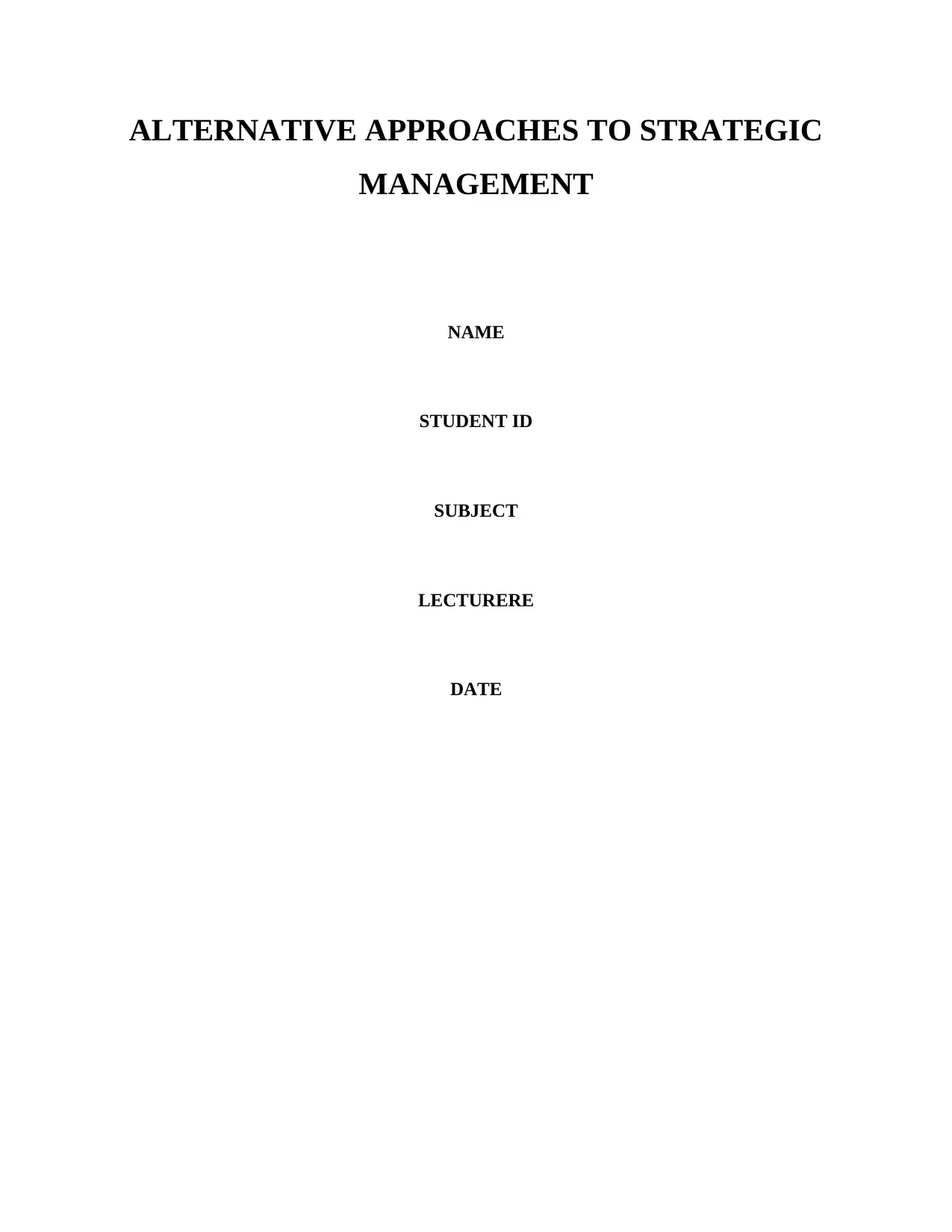
ALTERNATIVE APPROACHES TO STRATEGIC
MANAGEMENT
NAME
STUDENT ID
SUBJECT
LECTURERE
DATE
MANAGEMENT
NAME
STUDENT ID
SUBJECT
LECTURERE
DATE
Paraphrase This Document
Need a fresh take? Get an instant paraphrase of this document with our AI Paraphraser
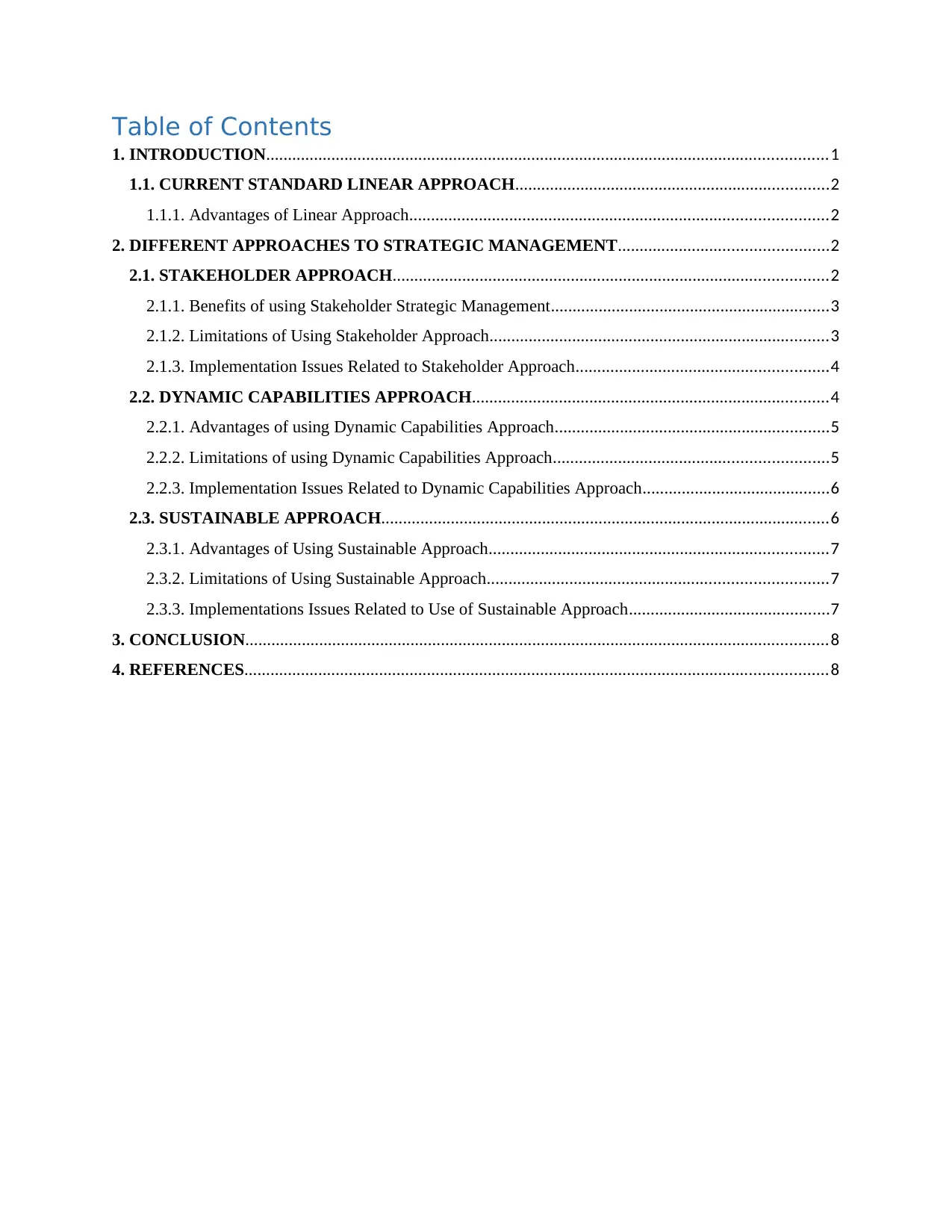
Table of Contents
1. INTRODUCTION.................................................................................................................................1
1.1. CURRENT STANDARD LINEAR APPROACH........................................................................2
1.1.1. Advantages of Linear Approach................................................................................................2
2. DIFFERENT APPROACHES TO STRATEGIC MANAGEMENT................................................2
2.1. STAKEHOLDER APPROACH....................................................................................................2
2.1.1. Benefits of using Stakeholder Strategic Management................................................................3
2.1.2. Limitations of Using Stakeholder Approach..............................................................................3
2.1.3. Implementation Issues Related to Stakeholder Approach..........................................................4
2.2. DYNAMIC CAPABILITIES APPROACH..................................................................................4
2.2.1. Advantages of using Dynamic Capabilities Approach...............................................................5
2.2.2. Limitations of using Dynamic Capabilities Approach...............................................................5
2.2.3. Implementation Issues Related to Dynamic Capabilities Approach...........................................6
2.3. SUSTAINABLE APPROACH.......................................................................................................6
2.3.1. Advantages of Using Sustainable Approach..............................................................................7
2.3.2. Limitations of Using Sustainable Approach..............................................................................7
2.3.3. Implementations Issues Related to Use of Sustainable Approach..............................................7
3. CONCLUSION......................................................................................................................................8
4. REFERENCES......................................................................................................................................8
1. INTRODUCTION.................................................................................................................................1
1.1. CURRENT STANDARD LINEAR APPROACH........................................................................2
1.1.1. Advantages of Linear Approach................................................................................................2
2. DIFFERENT APPROACHES TO STRATEGIC MANAGEMENT................................................2
2.1. STAKEHOLDER APPROACH....................................................................................................2
2.1.1. Benefits of using Stakeholder Strategic Management................................................................3
2.1.2. Limitations of Using Stakeholder Approach..............................................................................3
2.1.3. Implementation Issues Related to Stakeholder Approach..........................................................4
2.2. DYNAMIC CAPABILITIES APPROACH..................................................................................4
2.2.1. Advantages of using Dynamic Capabilities Approach...............................................................5
2.2.2. Limitations of using Dynamic Capabilities Approach...............................................................5
2.2.3. Implementation Issues Related to Dynamic Capabilities Approach...........................................6
2.3. SUSTAINABLE APPROACH.......................................................................................................6
2.3.1. Advantages of Using Sustainable Approach..............................................................................7
2.3.2. Limitations of Using Sustainable Approach..............................................................................7
2.3.3. Implementations Issues Related to Use of Sustainable Approach..............................................7
3. CONCLUSION......................................................................................................................................8
4. REFERENCES......................................................................................................................................8
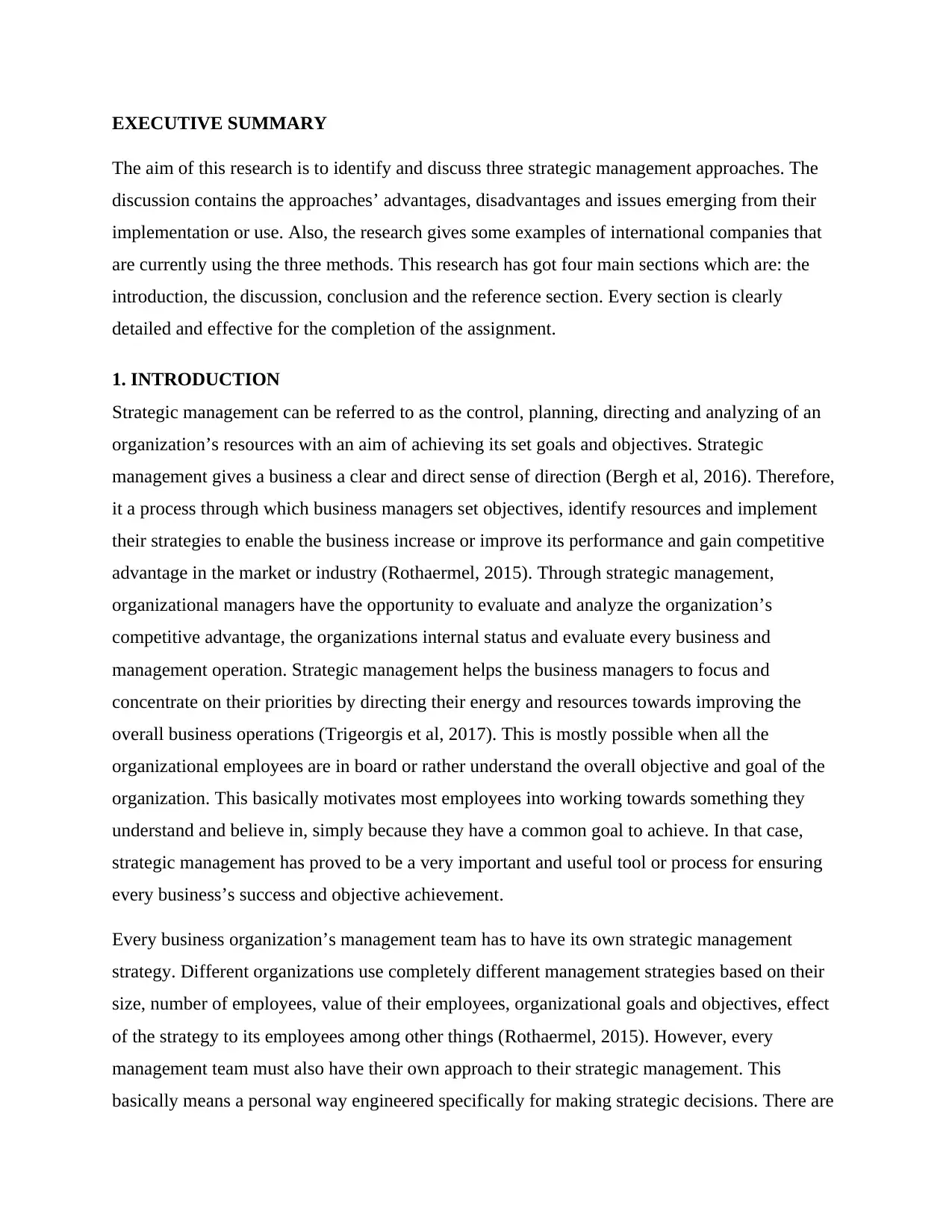
EXECUTIVE SUMMARY
The aim of this research is to identify and discuss three strategic management approaches. The
discussion contains the approaches’ advantages, disadvantages and issues emerging from their
implementation or use. Also, the research gives some examples of international companies that
are currently using the three methods. This research has got four main sections which are: the
introduction, the discussion, conclusion and the reference section. Every section is clearly
detailed and effective for the completion of the assignment.
1. INTRODUCTION
Strategic management can be referred to as the control, planning, directing and analyzing of an
organization’s resources with an aim of achieving its set goals and objectives. Strategic
management gives a business a clear and direct sense of direction (Bergh et al, 2016). Therefore,
it a process through which business managers set objectives, identify resources and implement
their strategies to enable the business increase or improve its performance and gain competitive
advantage in the market or industry (Rothaermel, 2015). Through strategic management,
organizational managers have the opportunity to evaluate and analyze the organization’s
competitive advantage, the organizations internal status and evaluate every business and
management operation. Strategic management helps the business managers to focus and
concentrate on their priorities by directing their energy and resources towards improving the
overall business operations (Trigeorgis et al, 2017). This is mostly possible when all the
organizational employees are in board or rather understand the overall objective and goal of the
organization. This basically motivates most employees into working towards something they
understand and believe in, simply because they have a common goal to achieve. In that case,
strategic management has proved to be a very important and useful tool or process for ensuring
every business’s success and objective achievement.
Every business organization’s management team has to have its own strategic management
strategy. Different organizations use completely different management strategies based on their
size, number of employees, value of their employees, organizational goals and objectives, effect
of the strategy to its employees among other things (Rothaermel, 2015). However, every
management team must also have their own approach to their strategic management. This
basically means a personal way engineered specifically for making strategic decisions. There are
The aim of this research is to identify and discuss three strategic management approaches. The
discussion contains the approaches’ advantages, disadvantages and issues emerging from their
implementation or use. Also, the research gives some examples of international companies that
are currently using the three methods. This research has got four main sections which are: the
introduction, the discussion, conclusion and the reference section. Every section is clearly
detailed and effective for the completion of the assignment.
1. INTRODUCTION
Strategic management can be referred to as the control, planning, directing and analyzing of an
organization’s resources with an aim of achieving its set goals and objectives. Strategic
management gives a business a clear and direct sense of direction (Bergh et al, 2016). Therefore,
it a process through which business managers set objectives, identify resources and implement
their strategies to enable the business increase or improve its performance and gain competitive
advantage in the market or industry (Rothaermel, 2015). Through strategic management,
organizational managers have the opportunity to evaluate and analyze the organization’s
competitive advantage, the organizations internal status and evaluate every business and
management operation. Strategic management helps the business managers to focus and
concentrate on their priorities by directing their energy and resources towards improving the
overall business operations (Trigeorgis et al, 2017). This is mostly possible when all the
organizational employees are in board or rather understand the overall objective and goal of the
organization. This basically motivates most employees into working towards something they
understand and believe in, simply because they have a common goal to achieve. In that case,
strategic management has proved to be a very important and useful tool or process for ensuring
every business’s success and objective achievement.
Every business organization’s management team has to have its own strategic management
strategy. Different organizations use completely different management strategies based on their
size, number of employees, value of their employees, organizational goals and objectives, effect
of the strategy to its employees among other things (Rothaermel, 2015). However, every
management team must also have their own approach to their strategic management. This
basically means a personal way engineered specifically for making strategic decisions. There are
⊘ This is a preview!⊘
Do you want full access?
Subscribe today to unlock all pages.

Trusted by 1+ million students worldwide
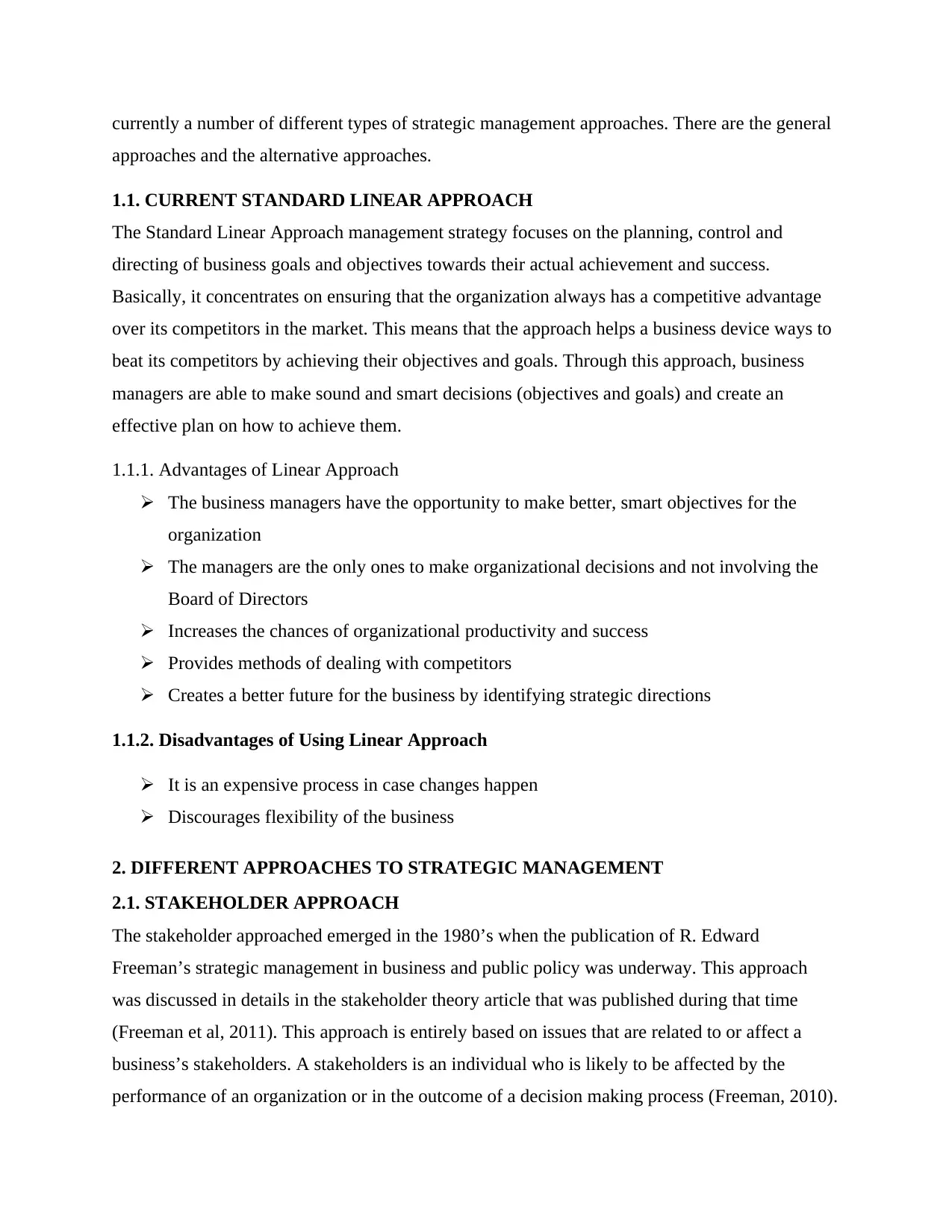
currently a number of different types of strategic management approaches. There are the general
approaches and the alternative approaches.
1.1. CURRENT STANDARD LINEAR APPROACH
The Standard Linear Approach management strategy focuses on the planning, control and
directing of business goals and objectives towards their actual achievement and success.
Basically, it concentrates on ensuring that the organization always has a competitive advantage
over its competitors in the market. This means that the approach helps a business device ways to
beat its competitors by achieving their objectives and goals. Through this approach, business
managers are able to make sound and smart decisions (objectives and goals) and create an
effective plan on how to achieve them.
1.1.1. Advantages of Linear Approach
The business managers have the opportunity to make better, smart objectives for the
organization
The managers are the only ones to make organizational decisions and not involving the
Board of Directors
Increases the chances of organizational productivity and success
Provides methods of dealing with competitors
Creates a better future for the business by identifying strategic directions
1.1.2. Disadvantages of Using Linear Approach
It is an expensive process in case changes happen
Discourages flexibility of the business
2. DIFFERENT APPROACHES TO STRATEGIC MANAGEMENT
2.1. STAKEHOLDER APPROACH
The stakeholder approached emerged in the 1980’s when the publication of R. Edward
Freeman’s strategic management in business and public policy was underway. This approach
was discussed in details in the stakeholder theory article that was published during that time
(Freeman et al, 2011). This approach is entirely based on issues that are related to or affect a
business’s stakeholders. A stakeholders is an individual who is likely to be affected by the
performance of an organization or in the outcome of a decision making process (Freeman, 2010).
approaches and the alternative approaches.
1.1. CURRENT STANDARD LINEAR APPROACH
The Standard Linear Approach management strategy focuses on the planning, control and
directing of business goals and objectives towards their actual achievement and success.
Basically, it concentrates on ensuring that the organization always has a competitive advantage
over its competitors in the market. This means that the approach helps a business device ways to
beat its competitors by achieving their objectives and goals. Through this approach, business
managers are able to make sound and smart decisions (objectives and goals) and create an
effective plan on how to achieve them.
1.1.1. Advantages of Linear Approach
The business managers have the opportunity to make better, smart objectives for the
organization
The managers are the only ones to make organizational decisions and not involving the
Board of Directors
Increases the chances of organizational productivity and success
Provides methods of dealing with competitors
Creates a better future for the business by identifying strategic directions
1.1.2. Disadvantages of Using Linear Approach
It is an expensive process in case changes happen
Discourages flexibility of the business
2. DIFFERENT APPROACHES TO STRATEGIC MANAGEMENT
2.1. STAKEHOLDER APPROACH
The stakeholder approached emerged in the 1980’s when the publication of R. Edward
Freeman’s strategic management in business and public policy was underway. This approach
was discussed in details in the stakeholder theory article that was published during that time
(Freeman et al, 2011). This approach is entirely based on issues that are related to or affect a
business’s stakeholders. A stakeholders is an individual who is likely to be affected by the
performance of an organization or in the outcome of a decision making process (Freeman, 2010).
Paraphrase This Document
Need a fresh take? Get an instant paraphrase of this document with our AI Paraphraser
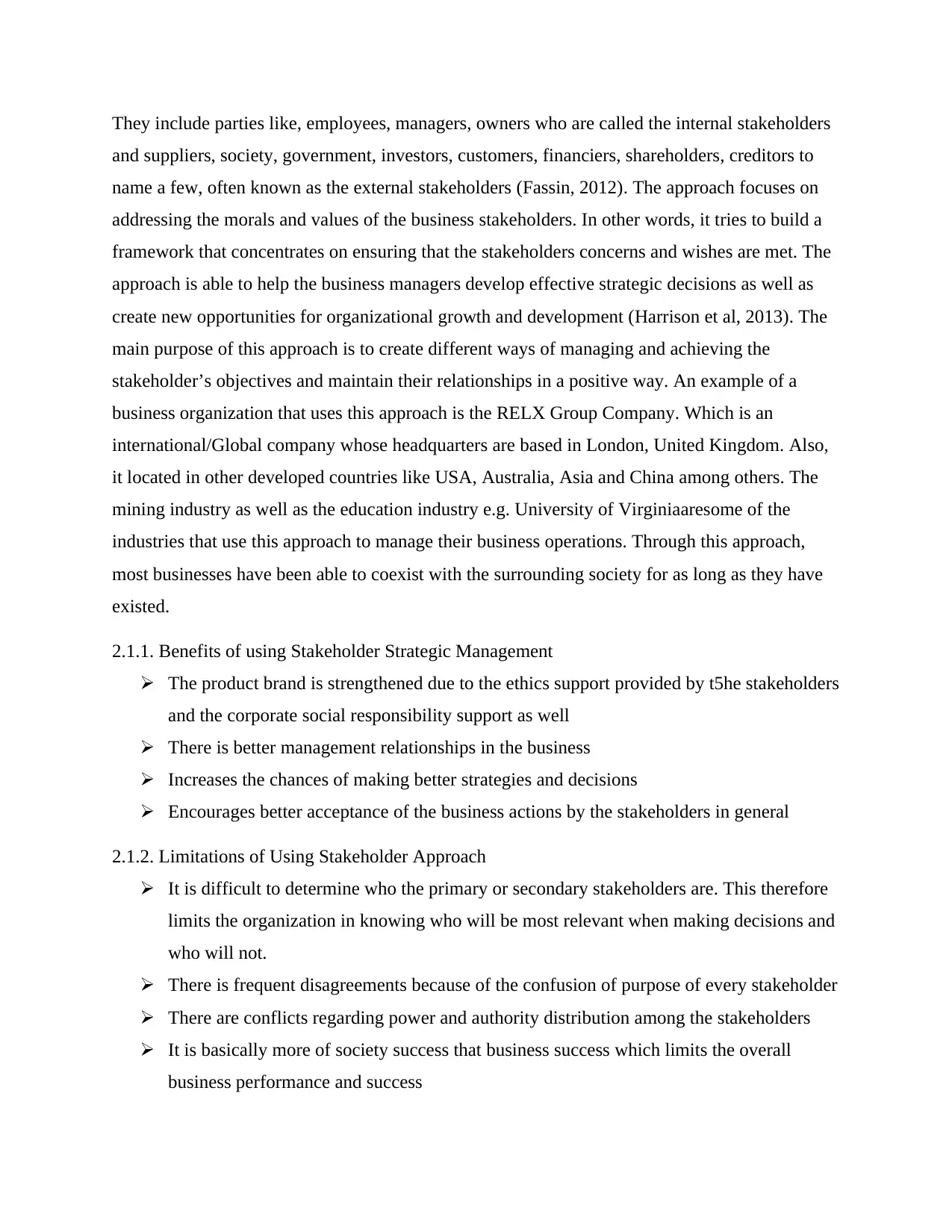
They include parties like, employees, managers, owners who are called the internal stakeholders
and suppliers, society, government, investors, customers, financiers, shareholders, creditors to
name a few, often known as the external stakeholders (Fassin, 2012). The approach focuses on
addressing the morals and values of the business stakeholders. In other words, it tries to build a
framework that concentrates on ensuring that the stakeholders concerns and wishes are met. The
approach is able to help the business managers develop effective strategic decisions as well as
create new opportunities for organizational growth and development (Harrison et al, 2013). The
main purpose of this approach is to create different ways of managing and achieving the
stakeholder’s objectives and maintain their relationships in a positive way. An example of a
business organization that uses this approach is the RELX Group Company. Which is an
international/Global company whose headquarters are based in London, United Kingdom. Also,
it located in other developed countries like USA, Australia, Asia and China among others. The
mining industry as well as the education industry e.g. University of Virginiaaresome of the
industries that use this approach to manage their business operations. Through this approach,
most businesses have been able to coexist with the surrounding society for as long as they have
existed.
2.1.1. Benefits of using Stakeholder Strategic Management
The product brand is strengthened due to the ethics support provided by t5he stakeholders
and the corporate social responsibility support as well
There is better management relationships in the business
Increases the chances of making better strategies and decisions
Encourages better acceptance of the business actions by the stakeholders in general
2.1.2. Limitations of Using Stakeholder Approach
It is difficult to determine who the primary or secondary stakeholders are. This therefore
limits the organization in knowing who will be most relevant when making decisions and
who will not.
There is frequent disagreements because of the confusion of purpose of every stakeholder
There are conflicts regarding power and authority distribution among the stakeholders
It is basically more of society success that business success which limits the overall
business performance and success
and suppliers, society, government, investors, customers, financiers, shareholders, creditors to
name a few, often known as the external stakeholders (Fassin, 2012). The approach focuses on
addressing the morals and values of the business stakeholders. In other words, it tries to build a
framework that concentrates on ensuring that the stakeholders concerns and wishes are met. The
approach is able to help the business managers develop effective strategic decisions as well as
create new opportunities for organizational growth and development (Harrison et al, 2013). The
main purpose of this approach is to create different ways of managing and achieving the
stakeholder’s objectives and maintain their relationships in a positive way. An example of a
business organization that uses this approach is the RELX Group Company. Which is an
international/Global company whose headquarters are based in London, United Kingdom. Also,
it located in other developed countries like USA, Australia, Asia and China among others. The
mining industry as well as the education industry e.g. University of Virginiaaresome of the
industries that use this approach to manage their business operations. Through this approach,
most businesses have been able to coexist with the surrounding society for as long as they have
existed.
2.1.1. Benefits of using Stakeholder Strategic Management
The product brand is strengthened due to the ethics support provided by t5he stakeholders
and the corporate social responsibility support as well
There is better management relationships in the business
Increases the chances of making better strategies and decisions
Encourages better acceptance of the business actions by the stakeholders in general
2.1.2. Limitations of Using Stakeholder Approach
It is difficult to determine who the primary or secondary stakeholders are. This therefore
limits the organization in knowing who will be most relevant when making decisions and
who will not.
There is frequent disagreements because of the confusion of purpose of every stakeholder
There are conflicts regarding power and authority distribution among the stakeholders
It is basically more of society success that business success which limits the overall
business performance and success
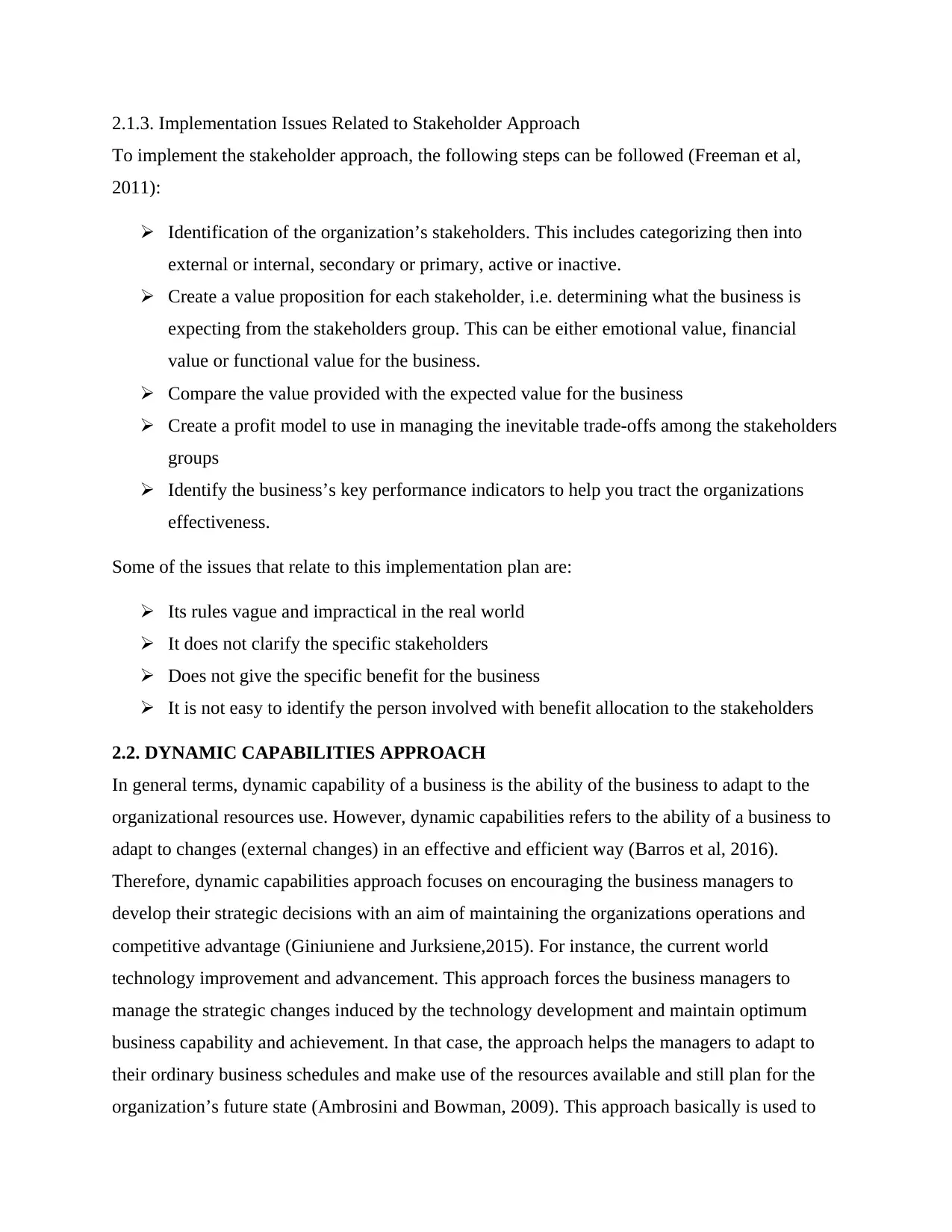
2.1.3. Implementation Issues Related to Stakeholder Approach
To implement the stakeholder approach, the following steps can be followed (Freeman et al,
2011):
Identification of the organization’s stakeholders. This includes categorizing then into
external or internal, secondary or primary, active or inactive.
Create a value proposition for each stakeholder, i.e. determining what the business is
expecting from the stakeholders group. This can be either emotional value, financial
value or functional value for the business.
Compare the value provided with the expected value for the business
Create a profit model to use in managing the inevitable trade-offs among the stakeholders
groups
Identify the business’s key performance indicators to help you tract the organizations
effectiveness.
Some of the issues that relate to this implementation plan are:
Its rules vague and impractical in the real world
It does not clarify the specific stakeholders
Does not give the specific benefit for the business
It is not easy to identify the person involved with benefit allocation to the stakeholders
2.2. DYNAMIC CAPABILITIES APPROACH
In general terms, dynamic capability of a business is the ability of the business to adapt to the
organizational resources use. However, dynamic capabilities refers to the ability of a business to
adapt to changes (external changes) in an effective and efficient way (Barros et al, 2016).
Therefore, dynamic capabilities approach focuses on encouraging the business managers to
develop their strategic decisions with an aim of maintaining the organizations operations and
competitive advantage (Giniuniene and Jurksiene,2015). For instance, the current world
technology improvement and advancement. This approach forces the business managers to
manage the strategic changes induced by the technology development and maintain optimum
business capability and achievement. In that case, the approach helps the managers to adapt to
their ordinary business schedules and make use of the resources available and still plan for the
organization’s future state (Ambrosini and Bowman, 2009). This approach basically is used to
To implement the stakeholder approach, the following steps can be followed (Freeman et al,
2011):
Identification of the organization’s stakeholders. This includes categorizing then into
external or internal, secondary or primary, active or inactive.
Create a value proposition for each stakeholder, i.e. determining what the business is
expecting from the stakeholders group. This can be either emotional value, financial
value or functional value for the business.
Compare the value provided with the expected value for the business
Create a profit model to use in managing the inevitable trade-offs among the stakeholders
groups
Identify the business’s key performance indicators to help you tract the organizations
effectiveness.
Some of the issues that relate to this implementation plan are:
Its rules vague and impractical in the real world
It does not clarify the specific stakeholders
Does not give the specific benefit for the business
It is not easy to identify the person involved with benefit allocation to the stakeholders
2.2. DYNAMIC CAPABILITIES APPROACH
In general terms, dynamic capability of a business is the ability of the business to adapt to the
organizational resources use. However, dynamic capabilities refers to the ability of a business to
adapt to changes (external changes) in an effective and efficient way (Barros et al, 2016).
Therefore, dynamic capabilities approach focuses on encouraging the business managers to
develop their strategic decisions with an aim of maintaining the organizations operations and
competitive advantage (Giniuniene and Jurksiene,2015). For instance, the current world
technology improvement and advancement. This approach forces the business managers to
manage the strategic changes induced by the technology development and maintain optimum
business capability and achievement. In that case, the approach helps the managers to adapt to
their ordinary business schedules and make use of the resources available and still plan for the
organization’s future state (Ambrosini and Bowman, 2009). This approach basically is used to
⊘ This is a preview!⊘
Do you want full access?
Subscribe today to unlock all pages.

Trusted by 1+ million students worldwide
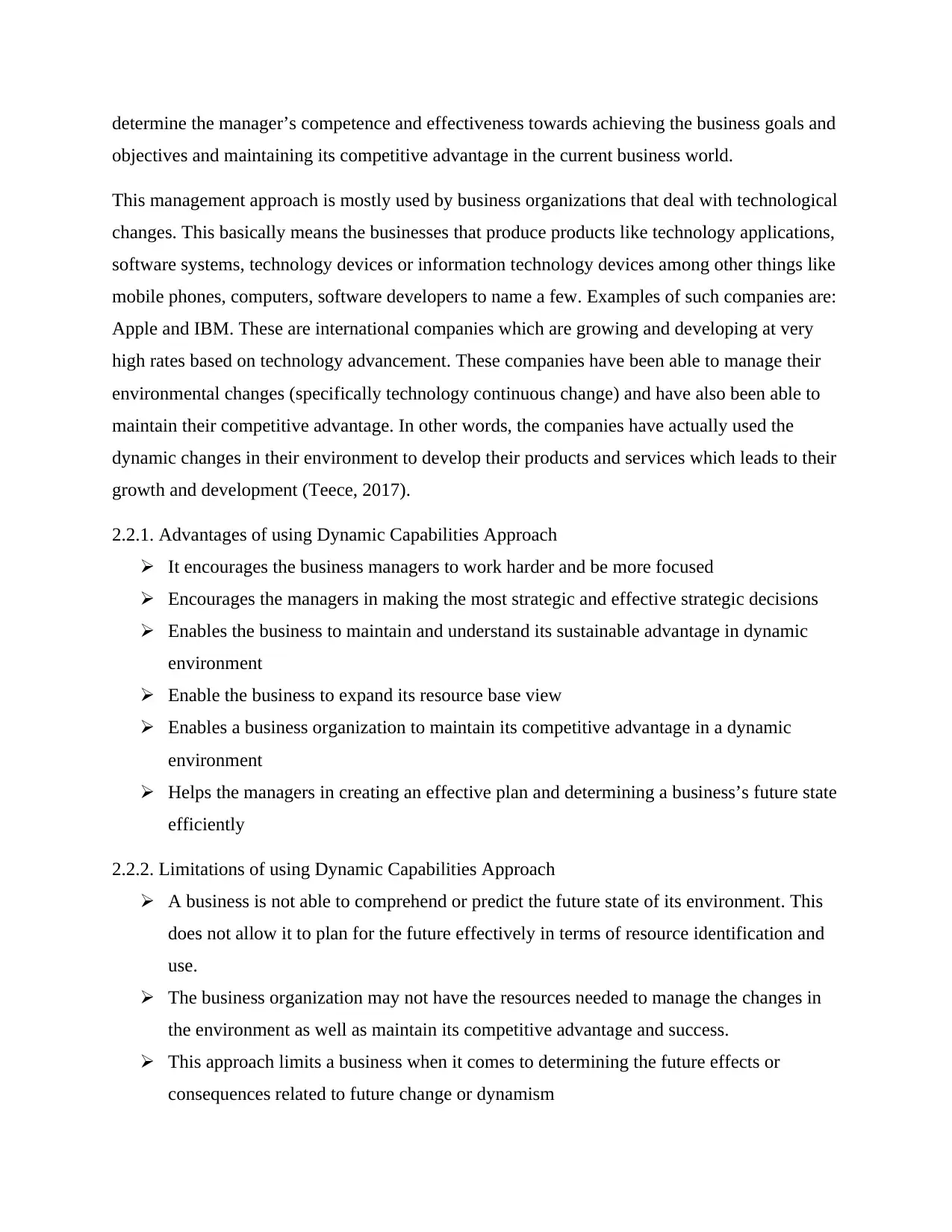
determine the manager’s competence and effectiveness towards achieving the business goals and
objectives and maintaining its competitive advantage in the current business world.
This management approach is mostly used by business organizations that deal with technological
changes. This basically means the businesses that produce products like technology applications,
software systems, technology devices or information technology devices among other things like
mobile phones, computers, software developers to name a few. Examples of such companies are:
Apple and IBM. These are international companies which are growing and developing at very
high rates based on technology advancement. These companies have been able to manage their
environmental changes (specifically technology continuous change) and have also been able to
maintain their competitive advantage. In other words, the companies have actually used the
dynamic changes in their environment to develop their products and services which leads to their
growth and development (Teece, 2017).
2.2.1. Advantages of using Dynamic Capabilities Approach
It encourages the business managers to work harder and be more focused
Encourages the managers in making the most strategic and effective strategic decisions
Enables the business to maintain and understand its sustainable advantage in dynamic
environment
Enable the business to expand its resource base view
Enables a business organization to maintain its competitive advantage in a dynamic
environment
Helps the managers in creating an effective plan and determining a business’s future state
efficiently
2.2.2. Limitations of using Dynamic Capabilities Approach
A business is not able to comprehend or predict the future state of its environment. This
does not allow it to plan for the future effectively in terms of resource identification and
use.
The business organization may not have the resources needed to manage the changes in
the environment as well as maintain its competitive advantage and success.
This approach limits a business when it comes to determining the future effects or
consequences related to future change or dynamism
objectives and maintaining its competitive advantage in the current business world.
This management approach is mostly used by business organizations that deal with technological
changes. This basically means the businesses that produce products like technology applications,
software systems, technology devices or information technology devices among other things like
mobile phones, computers, software developers to name a few. Examples of such companies are:
Apple and IBM. These are international companies which are growing and developing at very
high rates based on technology advancement. These companies have been able to manage their
environmental changes (specifically technology continuous change) and have also been able to
maintain their competitive advantage. In other words, the companies have actually used the
dynamic changes in their environment to develop their products and services which leads to their
growth and development (Teece, 2017).
2.2.1. Advantages of using Dynamic Capabilities Approach
It encourages the business managers to work harder and be more focused
Encourages the managers in making the most strategic and effective strategic decisions
Enables the business to maintain and understand its sustainable advantage in dynamic
environment
Enable the business to expand its resource base view
Enables a business organization to maintain its competitive advantage in a dynamic
environment
Helps the managers in creating an effective plan and determining a business’s future state
efficiently
2.2.2. Limitations of using Dynamic Capabilities Approach
A business is not able to comprehend or predict the future state of its environment. This
does not allow it to plan for the future effectively in terms of resource identification and
use.
The business organization may not have the resources needed to manage the changes in
the environment as well as maintain its competitive advantage and success.
This approach limits a business when it comes to determining the future effects or
consequences related to future change or dynamism
Paraphrase This Document
Need a fresh take? Get an instant paraphrase of this document with our AI Paraphraser
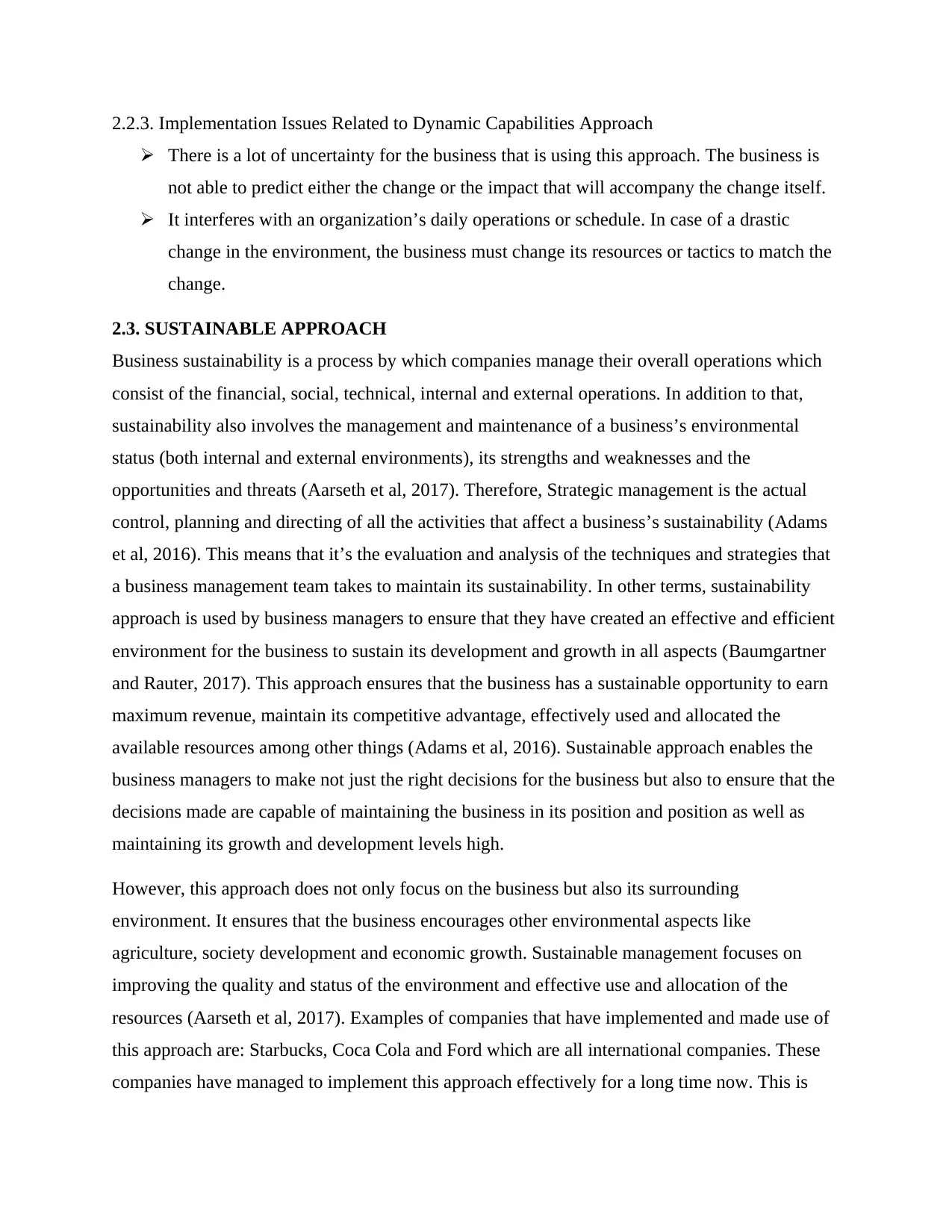
2.2.3. Implementation Issues Related to Dynamic Capabilities Approach
There is a lot of uncertainty for the business that is using this approach. The business is
not able to predict either the change or the impact that will accompany the change itself.
It interferes with an organization’s daily operations or schedule. In case of a drastic
change in the environment, the business must change its resources or tactics to match the
change.
2.3. SUSTAINABLE APPROACH
Business sustainability is a process by which companies manage their overall operations which
consist of the financial, social, technical, internal and external operations. In addition to that,
sustainability also involves the management and maintenance of a business’s environmental
status (both internal and external environments), its strengths and weaknesses and the
opportunities and threats (Aarseth et al, 2017). Therefore, Strategic management is the actual
control, planning and directing of all the activities that affect a business’s sustainability (Adams
et al, 2016). This means that it’s the evaluation and analysis of the techniques and strategies that
a business management team takes to maintain its sustainability. In other terms, sustainability
approach is used by business managers to ensure that they have created an effective and efficient
environment for the business to sustain its development and growth in all aspects (Baumgartner
and Rauter, 2017). This approach ensures that the business has a sustainable opportunity to earn
maximum revenue, maintain its competitive advantage, effectively used and allocated the
available resources among other things (Adams et al, 2016). Sustainable approach enables the
business managers to make not just the right decisions for the business but also to ensure that the
decisions made are capable of maintaining the business in its position and position as well as
maintaining its growth and development levels high.
However, this approach does not only focus on the business but also its surrounding
environment. It ensures that the business encourages other environmental aspects like
agriculture, society development and economic growth. Sustainable management focuses on
improving the quality and status of the environment and effective use and allocation of the
resources (Aarseth et al, 2017). Examples of companies that have implemented and made use of
this approach are: Starbucks, Coca Cola and Ford which are all international companies. These
companies have managed to implement this approach effectively for a long time now. This is
There is a lot of uncertainty for the business that is using this approach. The business is
not able to predict either the change or the impact that will accompany the change itself.
It interferes with an organization’s daily operations or schedule. In case of a drastic
change in the environment, the business must change its resources or tactics to match the
change.
2.3. SUSTAINABLE APPROACH
Business sustainability is a process by which companies manage their overall operations which
consist of the financial, social, technical, internal and external operations. In addition to that,
sustainability also involves the management and maintenance of a business’s environmental
status (both internal and external environments), its strengths and weaknesses and the
opportunities and threats (Aarseth et al, 2017). Therefore, Strategic management is the actual
control, planning and directing of all the activities that affect a business’s sustainability (Adams
et al, 2016). This means that it’s the evaluation and analysis of the techniques and strategies that
a business management team takes to maintain its sustainability. In other terms, sustainability
approach is used by business managers to ensure that they have created an effective and efficient
environment for the business to sustain its development and growth in all aspects (Baumgartner
and Rauter, 2017). This approach ensures that the business has a sustainable opportunity to earn
maximum revenue, maintain its competitive advantage, effectively used and allocated the
available resources among other things (Adams et al, 2016). Sustainable approach enables the
business managers to make not just the right decisions for the business but also to ensure that the
decisions made are capable of maintaining the business in its position and position as well as
maintaining its growth and development levels high.
However, this approach does not only focus on the business but also its surrounding
environment. It ensures that the business encourages other environmental aspects like
agriculture, society development and economic growth. Sustainable management focuses on
improving the quality and status of the environment and effective use and allocation of the
resources (Aarseth et al, 2017). Examples of companies that have implemented and made use of
this approach are: Starbucks, Coca Cola and Ford which are all international companies. These
companies have managed to implement this approach effectively for a long time now. This is
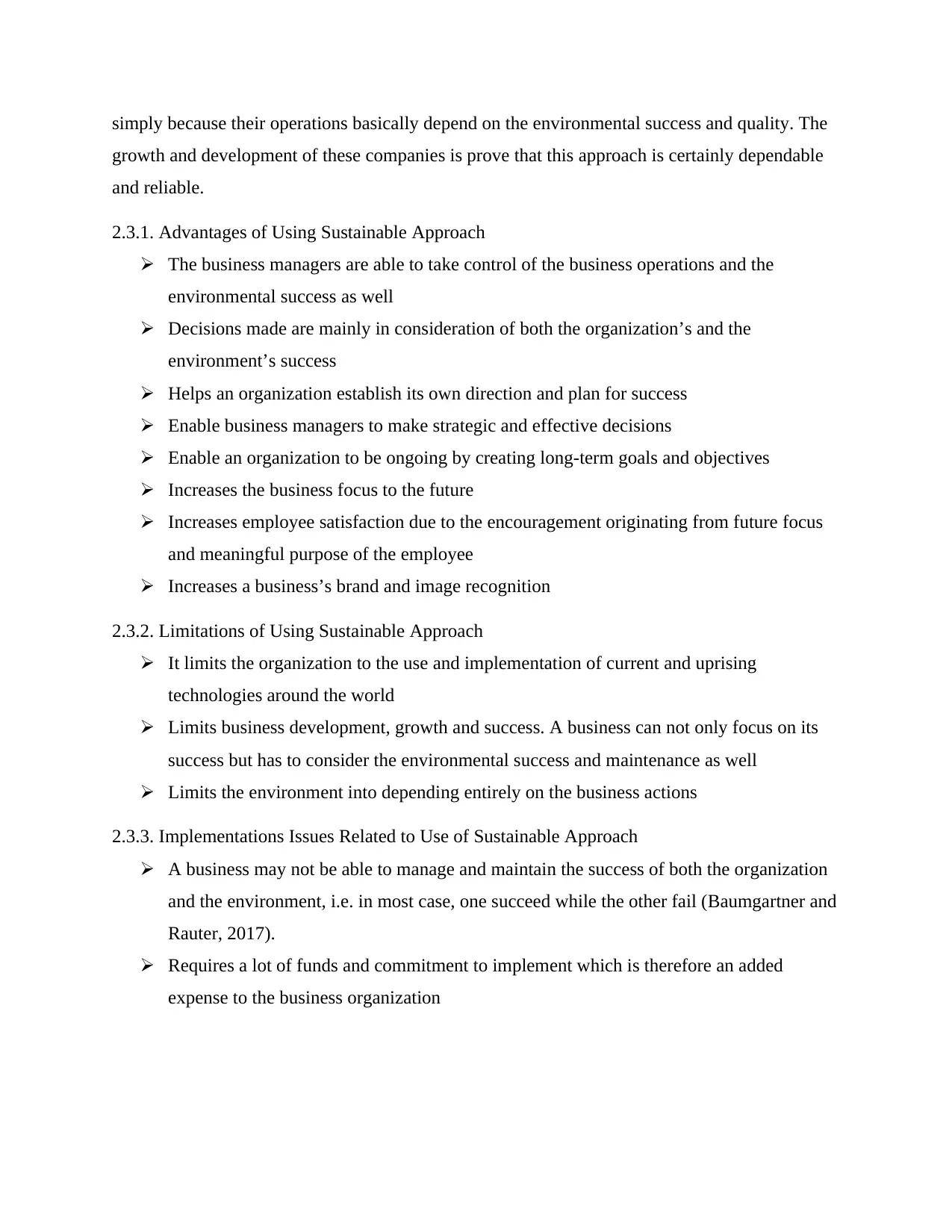
simply because their operations basically depend on the environmental success and quality. The
growth and development of these companies is prove that this approach is certainly dependable
and reliable.
2.3.1. Advantages of Using Sustainable Approach
The business managers are able to take control of the business operations and the
environmental success as well
Decisions made are mainly in consideration of both the organization’s and the
environment’s success
Helps an organization establish its own direction and plan for success
Enable business managers to make strategic and effective decisions
Enable an organization to be ongoing by creating long-term goals and objectives
Increases the business focus to the future
Increases employee satisfaction due to the encouragement originating from future focus
and meaningful purpose of the employee
Increases a business’s brand and image recognition
2.3.2. Limitations of Using Sustainable Approach
It limits the organization to the use and implementation of current and uprising
technologies around the world
Limits business development, growth and success. A business can not only focus on its
success but has to consider the environmental success and maintenance as well
Limits the environment into depending entirely on the business actions
2.3.3. Implementations Issues Related to Use of Sustainable Approach
A business may not be able to manage and maintain the success of both the organization
and the environment, i.e. in most case, one succeed while the other fail (Baumgartner and
Rauter, 2017).
Requires a lot of funds and commitment to implement which is therefore an added
expense to the business organization
growth and development of these companies is prove that this approach is certainly dependable
and reliable.
2.3.1. Advantages of Using Sustainable Approach
The business managers are able to take control of the business operations and the
environmental success as well
Decisions made are mainly in consideration of both the organization’s and the
environment’s success
Helps an organization establish its own direction and plan for success
Enable business managers to make strategic and effective decisions
Enable an organization to be ongoing by creating long-term goals and objectives
Increases the business focus to the future
Increases employee satisfaction due to the encouragement originating from future focus
and meaningful purpose of the employee
Increases a business’s brand and image recognition
2.3.2. Limitations of Using Sustainable Approach
It limits the organization to the use and implementation of current and uprising
technologies around the world
Limits business development, growth and success. A business can not only focus on its
success but has to consider the environmental success and maintenance as well
Limits the environment into depending entirely on the business actions
2.3.3. Implementations Issues Related to Use of Sustainable Approach
A business may not be able to manage and maintain the success of both the organization
and the environment, i.e. in most case, one succeed while the other fail (Baumgartner and
Rauter, 2017).
Requires a lot of funds and commitment to implement which is therefore an added
expense to the business organization
⊘ This is a preview!⊘
Do you want full access?
Subscribe today to unlock all pages.

Trusted by 1+ million students worldwide
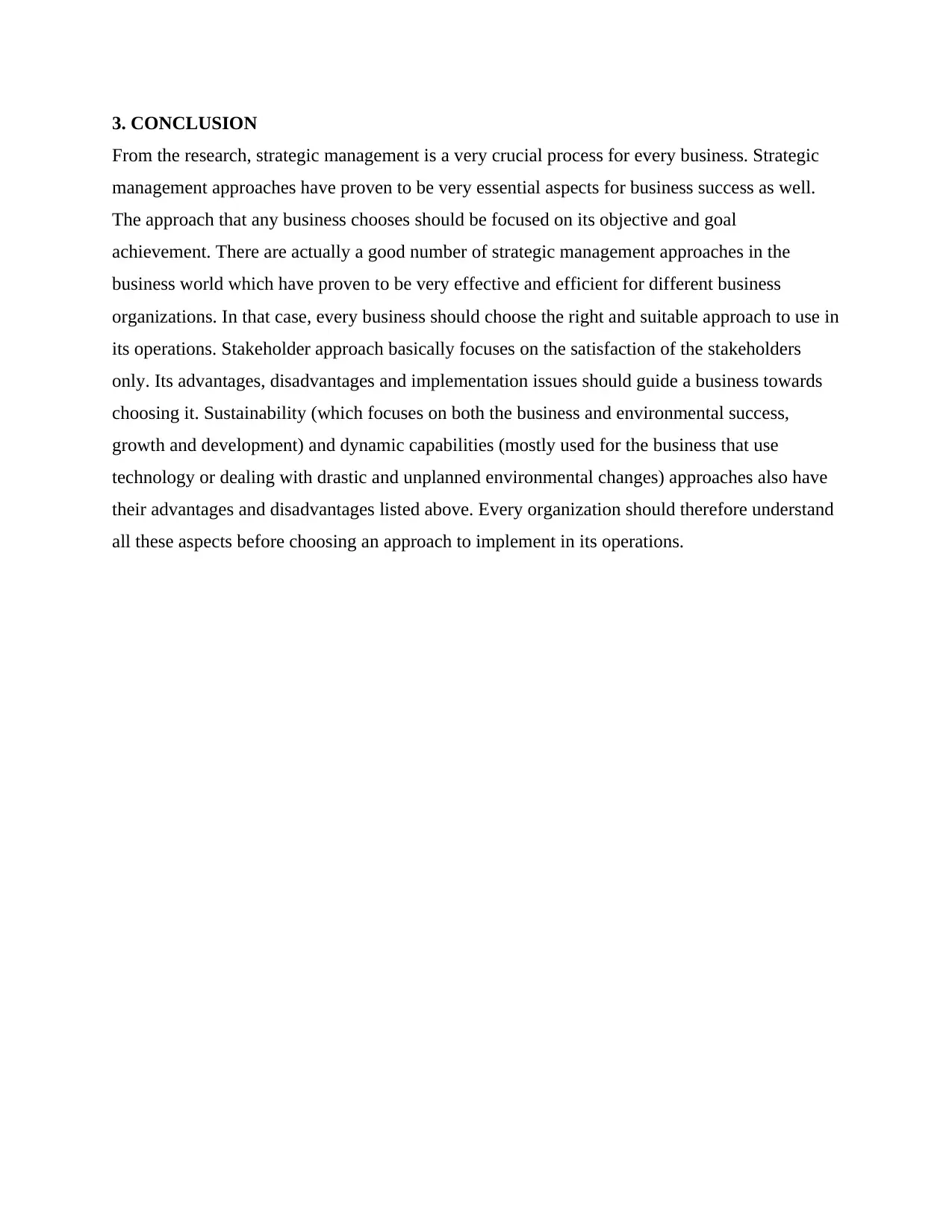
3. CONCLUSION
From the research, strategic management is a very crucial process for every business. Strategic
management approaches have proven to be very essential aspects for business success as well.
The approach that any business chooses should be focused on its objective and goal
achievement. There are actually a good number of strategic management approaches in the
business world which have proven to be very effective and efficient for different business
organizations. In that case, every business should choose the right and suitable approach to use in
its operations. Stakeholder approach basically focuses on the satisfaction of the stakeholders
only. Its advantages, disadvantages and implementation issues should guide a business towards
choosing it. Sustainability (which focuses on both the business and environmental success,
growth and development) and dynamic capabilities (mostly used for the business that use
technology or dealing with drastic and unplanned environmental changes) approaches also have
their advantages and disadvantages listed above. Every organization should therefore understand
all these aspects before choosing an approach to implement in its operations.
From the research, strategic management is a very crucial process for every business. Strategic
management approaches have proven to be very essential aspects for business success as well.
The approach that any business chooses should be focused on its objective and goal
achievement. There are actually a good number of strategic management approaches in the
business world which have proven to be very effective and efficient for different business
organizations. In that case, every business should choose the right and suitable approach to use in
its operations. Stakeholder approach basically focuses on the satisfaction of the stakeholders
only. Its advantages, disadvantages and implementation issues should guide a business towards
choosing it. Sustainability (which focuses on both the business and environmental success,
growth and development) and dynamic capabilities (mostly used for the business that use
technology or dealing with drastic and unplanned environmental changes) approaches also have
their advantages and disadvantages listed above. Every organization should therefore understand
all these aspects before choosing an approach to implement in its operations.
Paraphrase This Document
Need a fresh take? Get an instant paraphrase of this document with our AI Paraphraser
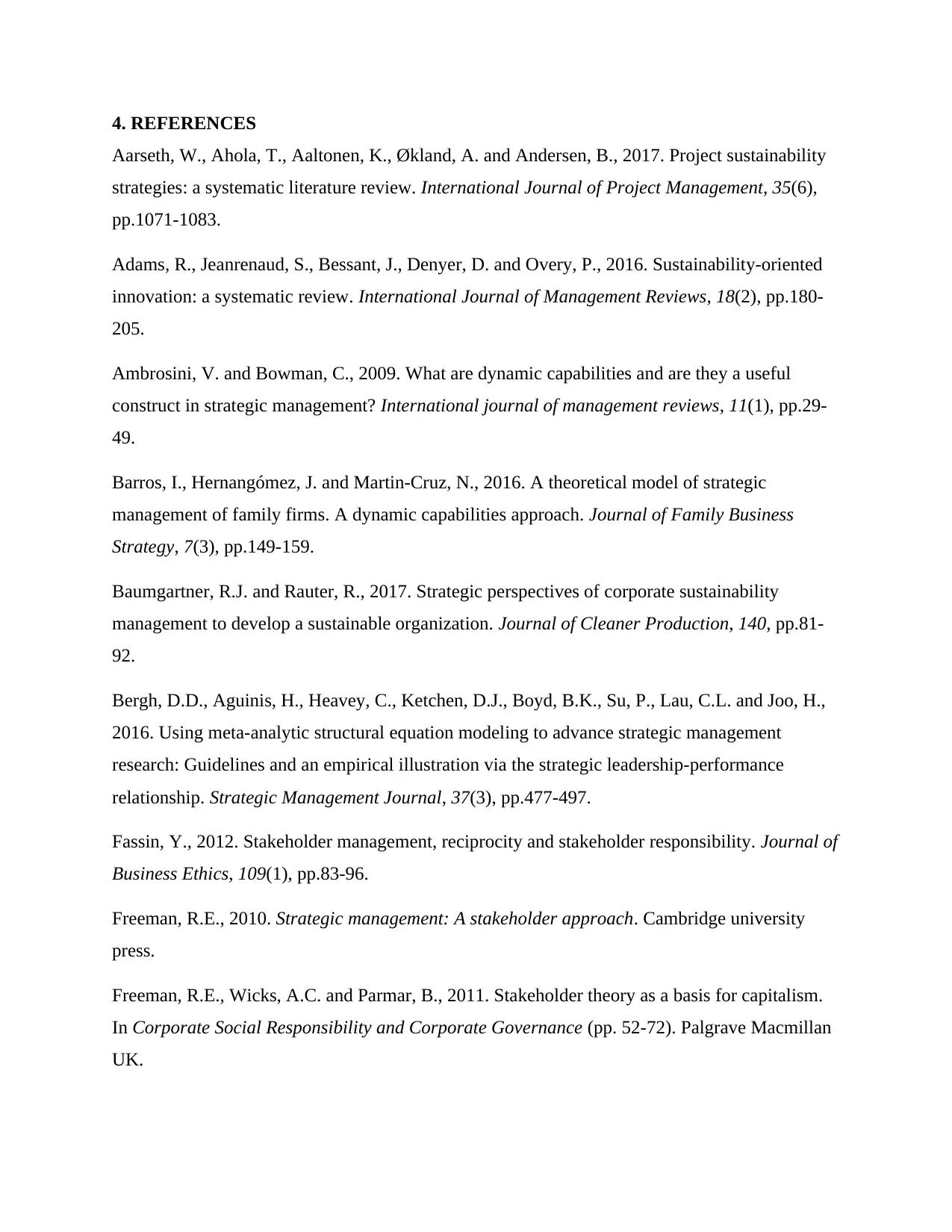
4. REFERENCES
Aarseth, W., Ahola, T., Aaltonen, K., Økland, A. and Andersen, B., 2017. Project sustainability
strategies: a systematic literature review. International Journal of Project Management, 35(6),
pp.1071-1083.
Adams, R., Jeanrenaud, S., Bessant, J., Denyer, D. and Overy, P., 2016. Sustainability‐oriented
innovation: a systematic review. International Journal of Management Reviews, 18(2), pp.180-
205.
Ambrosini, V. and Bowman, C., 2009. What are dynamic capabilities and are they a useful
construct in strategic management? International journal of management reviews, 11(1), pp.29-
49.
Barros, I., Hernangómez, J. and Martin-Cruz, N., 2016. A theoretical model of strategic
management of family firms. A dynamic capabilities approach. Journal of Family Business
Strategy, 7(3), pp.149-159.
Baumgartner, R.J. and Rauter, R., 2017. Strategic perspectives of corporate sustainability
management to develop a sustainable organization. Journal of Cleaner Production, 140, pp.81-
92.
Bergh, D.D., Aguinis, H., Heavey, C., Ketchen, D.J., Boyd, B.K., Su, P., Lau, C.L. and Joo, H.,
2016. Using meta‐analytic structural equation modeling to advance strategic management
research: Guidelines and an empirical illustration via the strategic leadership‐performance
relationship. Strategic Management Journal, 37(3), pp.477-497.
Fassin, Y., 2012. Stakeholder management, reciprocity and stakeholder responsibility. Journal of
Business Ethics, 109(1), pp.83-96.
Freeman, R.E., 2010. Strategic management: A stakeholder approach. Cambridge university
press.
Freeman, R.E., Wicks, A.C. and Parmar, B., 2011. Stakeholder theory as a basis for capitalism.
In Corporate Social Responsibility and Corporate Governance (pp. 52-72). Palgrave Macmillan
UK.
Aarseth, W., Ahola, T., Aaltonen, K., Økland, A. and Andersen, B., 2017. Project sustainability
strategies: a systematic literature review. International Journal of Project Management, 35(6),
pp.1071-1083.
Adams, R., Jeanrenaud, S., Bessant, J., Denyer, D. and Overy, P., 2016. Sustainability‐oriented
innovation: a systematic review. International Journal of Management Reviews, 18(2), pp.180-
205.
Ambrosini, V. and Bowman, C., 2009. What are dynamic capabilities and are they a useful
construct in strategic management? International journal of management reviews, 11(1), pp.29-
49.
Barros, I., Hernangómez, J. and Martin-Cruz, N., 2016. A theoretical model of strategic
management of family firms. A dynamic capabilities approach. Journal of Family Business
Strategy, 7(3), pp.149-159.
Baumgartner, R.J. and Rauter, R., 2017. Strategic perspectives of corporate sustainability
management to develop a sustainable organization. Journal of Cleaner Production, 140, pp.81-
92.
Bergh, D.D., Aguinis, H., Heavey, C., Ketchen, D.J., Boyd, B.K., Su, P., Lau, C.L. and Joo, H.,
2016. Using meta‐analytic structural equation modeling to advance strategic management
research: Guidelines and an empirical illustration via the strategic leadership‐performance
relationship. Strategic Management Journal, 37(3), pp.477-497.
Fassin, Y., 2012. Stakeholder management, reciprocity and stakeholder responsibility. Journal of
Business Ethics, 109(1), pp.83-96.
Freeman, R.E., 2010. Strategic management: A stakeholder approach. Cambridge university
press.
Freeman, R.E., Wicks, A.C. and Parmar, B., 2011. Stakeholder theory as a basis for capitalism.
In Corporate Social Responsibility and Corporate Governance (pp. 52-72). Palgrave Macmillan
UK.
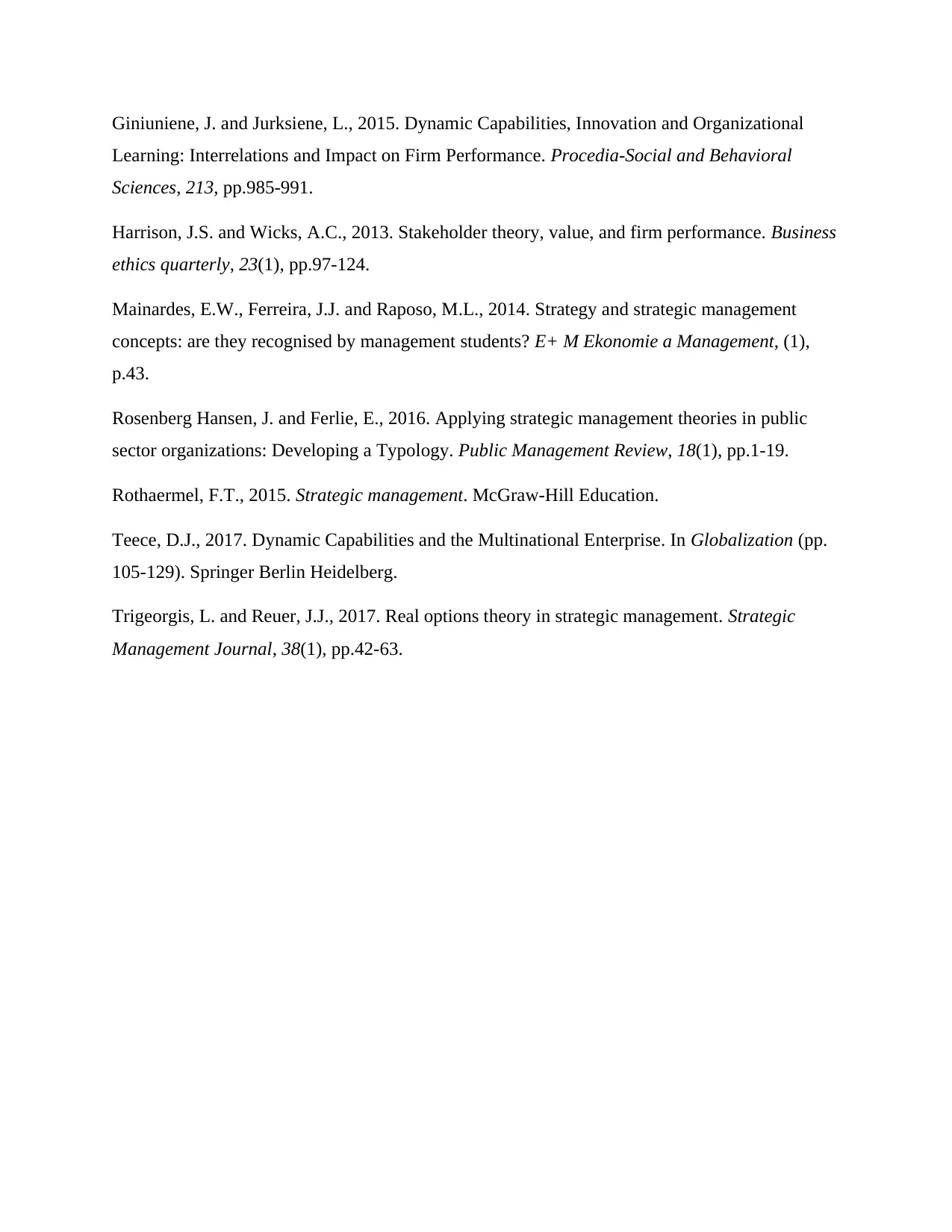
Giniuniene, J. and Jurksiene, L., 2015. Dynamic Capabilities, Innovation and Organizational
Learning: Interrelations and Impact on Firm Performance. Procedia-Social and Behavioral
Sciences, 213, pp.985-991.
Harrison, J.S. and Wicks, A.C., 2013. Stakeholder theory, value, and firm performance. Business
ethics quarterly, 23(1), pp.97-124.
Mainardes, E.W., Ferreira, J.J. and Raposo, M.L., 2014. Strategy and strategic management
concepts: are they recognised by management students? E+ M Ekonomie a Management, (1),
p.43.
Rosenberg Hansen, J. and Ferlie, E., 2016. Applying strategic management theories in public
sector organizations: Developing a Typology. Public Management Review, 18(1), pp.1-19.
Rothaermel, F.T., 2015. Strategic management. McGraw-Hill Education.
Teece, D.J., 2017. Dynamic Capabilities and the Multinational Enterprise. In Globalization (pp.
105-129). Springer Berlin Heidelberg.
Trigeorgis, L. and Reuer, J.J., 2017. Real options theory in strategic management. Strategic
Management Journal, 38(1), pp.42-63.
Learning: Interrelations and Impact on Firm Performance. Procedia-Social and Behavioral
Sciences, 213, pp.985-991.
Harrison, J.S. and Wicks, A.C., 2013. Stakeholder theory, value, and firm performance. Business
ethics quarterly, 23(1), pp.97-124.
Mainardes, E.W., Ferreira, J.J. and Raposo, M.L., 2014. Strategy and strategic management
concepts: are they recognised by management students? E+ M Ekonomie a Management, (1),
p.43.
Rosenberg Hansen, J. and Ferlie, E., 2016. Applying strategic management theories in public
sector organizations: Developing a Typology. Public Management Review, 18(1), pp.1-19.
Rothaermel, F.T., 2015. Strategic management. McGraw-Hill Education.
Teece, D.J., 2017. Dynamic Capabilities and the Multinational Enterprise. In Globalization (pp.
105-129). Springer Berlin Heidelberg.
Trigeorgis, L. and Reuer, J.J., 2017. Real options theory in strategic management. Strategic
Management Journal, 38(1), pp.42-63.
⊘ This is a preview!⊘
Do you want full access?
Subscribe today to unlock all pages.

Trusted by 1+ million students worldwide
1 out of 12
Related Documents
Your All-in-One AI-Powered Toolkit for Academic Success.
+13062052269
info@desklib.com
Available 24*7 on WhatsApp / Email
![[object Object]](/_next/static/media/star-bottom.7253800d.svg)
Unlock your academic potential
Copyright © 2020–2025 A2Z Services. All Rights Reserved. Developed and managed by ZUCOL.





